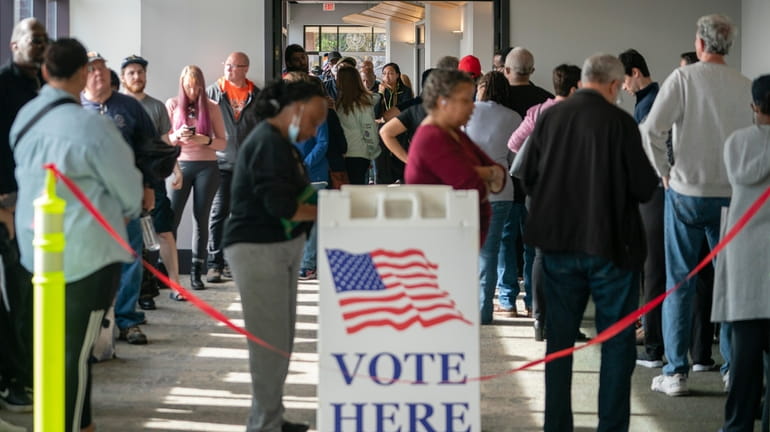Where abortion will be on the ballot in 2024

People are seen in line to vote on the first day of early voting in Cobb County. Credit: For The Washington Post/Elijah Nouvelage
The abortion rights issue was a political lifesaver for Democrats this year. Whether it will be again in 2024 depends in part on efforts to put the question of reproductive rights on the ballot — not just through the candidates’ positions, but literally.
The issue helped to fend off a red wave by both motivating the base and persuading undecided voters. Restrictive abortion laws are out of touch with public opinion, which was made resoundingly clear the six out of six times voters were asked about the issue in Vermont, California, Kentucky, Michigan, Montana and Kansas. Now abortion activists are asking which other states are ripe for initiatives to protect reproductive rights.
For Democrats, the stakes are even higher than they were this year. In 2024, they will be playing defense not only with the White House, but also with 23 Senate seats (including two independents). Republicans, meanwhile, have only 10 Senate seats to defend, with most in solidly red states.
As the fight over abortion rights plays out, keep an eye on two states in particular — Missouri and Ohio — where efforts are further along. The questions are whether and how reproductive-rights groups move forward with ballot initiatives, and what sort of resistance they face from their pro-life counterparts.
Depending on the state, there are a number of ways measures can get on the ballot. Legislatures can produce ballot initiatives that either restrict or enhance abortion rights. Legislators in New Jersey , for example, are currently looking into a ballot measure for next year to enshrine abortion rights in the state constitution.
Another way is for citizens to petition to get measures on the ballot. That’s an option in 22 states plus the District of Columbia; of those, only in 17 can a ballot measure modify the state’s constitution. That’s what happened in the purple state of Michigan, when voters this year established abortion rights as part of the state’s constitution, reelected Democratic Gov. Gretchen Whitmer and put Democrats in control of the state legislature for the first time since 1984.
In Ohio, the stakes are high for three-term Democratic Sen. Sherrod Brown, who is up for reelection in 2024. The state is solidly red, but nearly 60% of registered voters would support codifying abortion rights in the state’s constitution. On the ground, abortion access is mired in litigation.
After the Supreme Court overturned Roe v. Wade in June, the state legislature enacted a law banning abortion after six weeks. In October, a state court blocked that ban. That ruling is being appealed. And after November’s elections, says Jessie Hill, a professor at Case Western University who has been fighting the law, the Ohio Supreme Court has an anti-abortion majority.
If the court reinstates the ban, Hill says, “the only response to that would be a ballot initiative.” One complicating factor, she notes, is that Ohio’s Republican secretary of state has proposed a bill that would make it more difficult for citizen-led initiatives to get on the ballot.
In red states, Hill says, the data suggest that it’s easier to get people to vote against an abortion ban than it is to get them to vote in favor of an abortion rights amendment. That was the case in Kentucky and Kansas, where voters rejected abortion bans. How an amendment is phrased, she says, is crucial: whether to go broad and propose a blanket protection of abortion, or to use more narrow wording, for example to protect abortion only in the first trimester, in an attempt to appeal to more people.
Abortion proponents and foes are also eyeing Missouri, where there is a complete ban on abortion. In two years, there will be races for governor and secretary of state. Republican Sen. Josh Hawley, a Trump ally who won with 51.4% in 2018, is also up for reelection.
The state has a history of ballot initiatives. This year, 53% of voters supported a ballot initiative legalizing marijuana. In 2018, 62% approved a minimum wage hike. In 2020, they approved Medicaid expansion. It’s clear why Republicans, who have a majority in the state legislature, are pushing efforts to make the initiative petition process more onerous.
Abortion rights activists began looking into state ballot initiatives even before November’s midterms. They’re polling in several states and mining available voter data in Kansas, Michigan and Kentucky. They are also working with groups such as the Fairness Project, a progressive organization that helps develop and organize ballot measures, to determine what’s viable, raise money and draft language.
Kelly Hall, the Fairness Project’s executive director, acknowledges that there may be “coattail effects” from ballot measures that benefit Democratic candidates in 2024. But she also makes clear that the priority is protecting abortion rights: “Our view is let’s not let the tail wag the dog,” she says.
True enough. Still, if there are coattails, they’re ones Democrats can and should be chasing.
Julianna Goldman is a Bloomberg Opinion columnist who was formerly a Washington-based correspondent for CBS News and White House correspondent for Bloomberg News and Bloomberg Television.
